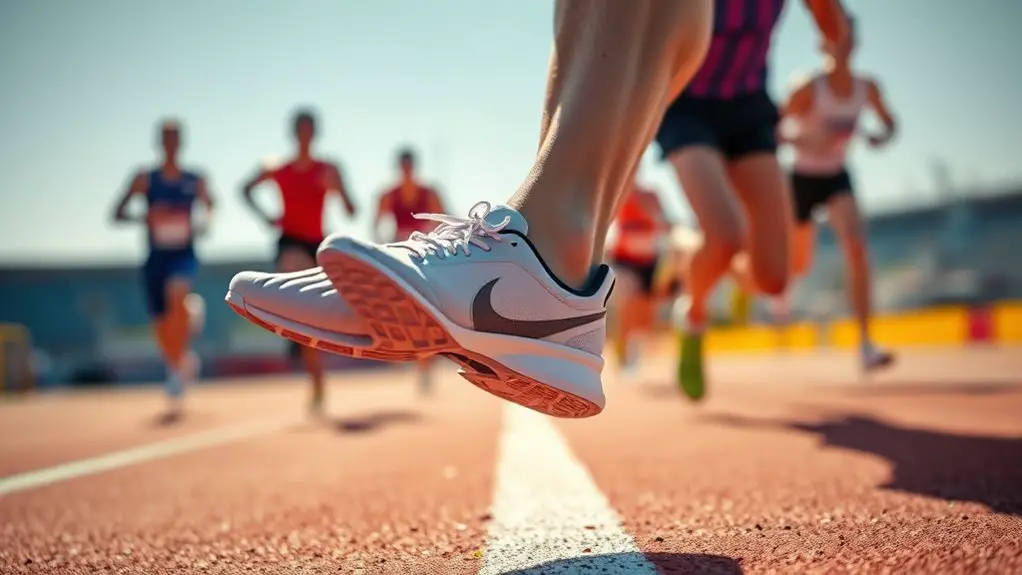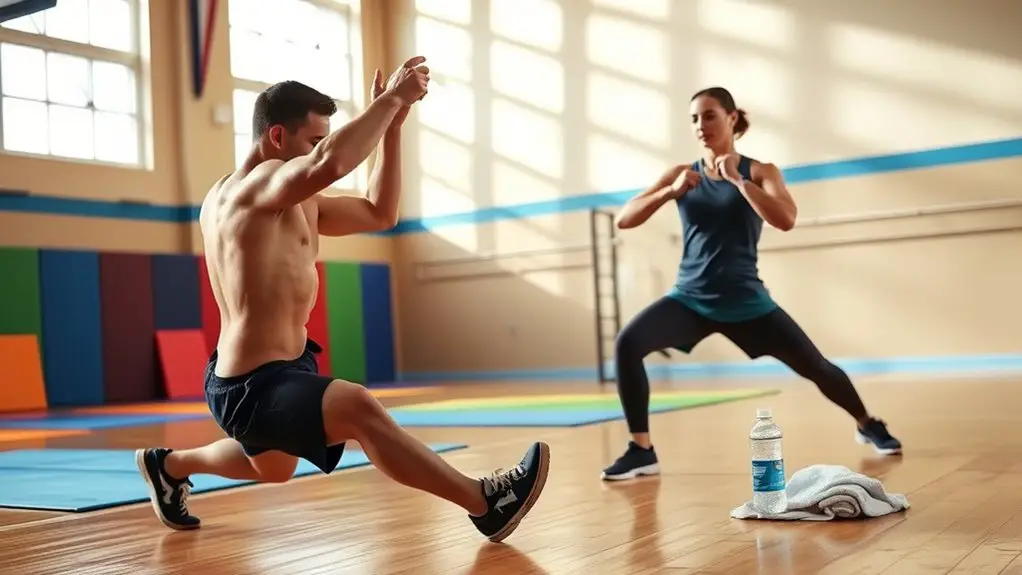Ankle dorsiflexion is essential for your athletic performance because it impacts movements like sprinting, jumping, and quick directional changes. When your toes point up toward your shin, it helps maintain balance and stability while improving force generation. Good dorsiflexion also enhances your ability to absorb shock and prevents injuries by allowing smooth and efficient movements. Want to access more insights on how to improve your performance through ankle flexibility? There's much more to explore!
Understanding Ankle Dorsiflexion
Ankle dorsiflexion refers to the movement where your toes point upwards toward your shin, allowing your foot to flex at the ankle joint. Understanding this movement is key to appreciating ankle anatomy and its role in your overall mobility. Dorsiflexion is essential for maintaining flexibility, enabling you to perform daily activities without restriction.
When your ankles are flexible, you've got the freedom to move efficiently, whether you're walking, running, or simply standing. Limited dorsiflexion can lead to discomfort and restrict your range of motion, impacting your performance. By prioritizing ankle flexibility, you not only enhance your physical capabilities but also promote better balance and stability. Additionally, strong, healthy joints play a critical role in optimizing your athletic performance and reducing injury risk.
The Role of Dorsiflexion in Athletic Movements
While you might not realize it, the role of dorsiflexion is essential in many athletic movements, influencing everything from sprinting to jumping. Proper ankle mechanics allow you to maintain an efficient stride, generating power through each push-off. When your ankle can flex adequately, you're better equipped to absorb force and shift smoothly into the next movement. This flexibility not only enhances your speed but also your overall athletic efficiency.
In activities like running, dorsiflexion helps you maintain a balanced center of gravity, ensuring you can push forward without losing momentum. Similarly, during jumps, it allows for ideal foot placement, maximizing your height and distance. Without sufficient dorsiflexion, you may find yourself struggling to reach your performance potential. Additionally, proper warm-up techniques are crucial to ensure your ankles are prepared for the demands of high-intensity activities. So, pay attention to your ankle mobility—it's a key ingredient in releasing your full athletic capabilities and enjoying the freedom of movement you crave.
Impact on Balance and Stability
When it comes to balance and stability, ankle dorsiflexion plays an essential role in your postural control. This flexibility not only enhances your athletic performance but also helps prevent injuries effectively. Understanding how it influences these aspects can help you optimize your movements and stay on your feet.
Role in Postural Control
Effective postural control hinges on your ability to maintain balance and stability, which is greatly influenced by dorsiflexion at the ankle. Proper ankle alignment allows your body mechanics to function smoothly, letting you navigate various terrains with ease. When your ankles can flex sufficiently, it enables greater control over your movements, ensuring you stay grounded even during challenging tasks. This flexibility helps your body react to unexpected shifts in weight, enhancing your overall stability. Without adequate dorsiflexion, you might find it hard to maintain that freedom of movement you crave, leading to potential falls or missteps. Prioritizing ankle mobility can empower you to move confidently, keeping your posture aligned and your balance intact.
Enhancing Athletic Performance
Ankle dorsiflexion plays an essential role in enhancing athletic performance, as it directly impacts your balance and stability. When you improve your ankle mobility, you're not just moving better; you're also optimizing your performance. This increased flexibility allows for more efficient movements, whether you're sprinting, jumping, or changing direction. With better dorsiflexion, you can maintain a stable base, which is vital for executing powerful athletic maneuvers. It helps distribute your weight evenly, reducing the risk of falls and improving overall control. Embracing practices that enhance your ankle mobility can lead to significant gains in performance optimization. By prioritizing this aspect of your training, you'll feel more agile and confident, setting the stage for your best athletic endeavors.
Preventing Injuries Effectively
Improving your ankle dorsiflexion not only boosts performance but also plays an important role in preventing injuries. When you enhance your ankle flexibility, you're setting yourself up for better balance and stability, vital for any active lifestyle. A flexible ankle allows your body to adapt to various surfaces and movements, reducing the risk of sprains or strains. It's essential during injury rehabilitation too; a strong foundation can prevent future issues from arising. By focusing on your ankle mobility, you can enjoy the freedom of movement without the constant worry of injury. So, invest time in exercises that promote dorsiflexion, and you'll not only feel the difference in your performance but also in your overall resilience.
Dorsiflexion and Injury Prevention
When you improve your ankle dorsiflexion, you enhance your stability mechanics, which is essential for preventing injuries. Better dorsiflexion allows for more efficient movement patterns, reducing the strain on your joints and muscles. By focusing on this aspect, you can lower your risk of injury during various activities. Additionally, proper warm-ups and stretching exercises can significantly enhance your ankle flexibility and strength, further contributing to injury prevention.
Enhanced Stability Mechanics
While many athletes focus on strength training, enhancing stability mechanics through proper dorsiflexion can greatly reduce the risk of injuries. By improving your ankle biomechanics, you create a strong foundation that supports your overall performance. Here are three key benefits of prioritizing dorsiflexion in your stability training:
- Improved Balance: Adequate dorsiflexion allows for better weight distribution, enhancing your balance during dynamic movements.
- Enhanced Agility: With increased ankle flexibility, you can change directions more efficiently, which is essential in many sports.
- Reduced Impact Stress: Proper dorsiflexion helps absorb shock during landing, minimizing strain on your joints.
Embracing these benefits not only keeps you moving freely but also empowers you to perform at your best.
Reduced Injury Risk
Adequate ankle dorsiflexion plays a significant role in reducing injury risk for athletes. When you have good ankle mobility, your body can absorb impact more effectively, helping to prevent strains and sprains. Limited dorsiflexion can lead to compensatory movements, putting additional stress on your knees and hips, which increases your risk of injury. By focusing on improving your ankle range of motion, you're not only enhancing your performance but also prioritizing injury prevention. Incorporating specific stretches and exercises into your routine can guarantee your ankles stay flexible and strong. Remember, the freedom to perform at your best lies in your ability to move fluidly. So, take care of those ankles, and enjoy the benefits that come with them!
Enhancing Power Generation
To enhance power generation, it's vital to focus on ankle dorsiflexion, as this movement plays a significant role in improving your athletic performance. Proper dorsiflexion allows for better force production and is important for executing explosive movements, which are key to various sports.
Here are three ways to enhance your power through ankle dorsiflexion:
- Strength Training: Incorporate exercises like squats and lunges, focusing on a full range of motion to improve muscle engagement and force output.
- Plyometrics: Engage in jump training to develop explosive power, emphasizing ankle flexion during takeoff for maximum force transfer.
- Mobility Work: Regularly stretch and mobilize your ankles to increase flexibility and range of motion, paving the way for improved performance. Additionally, performing Olympic lifts can further enhance your explosive strength and coordination, contributing to better power generation.
Assessing Dorsiflexion Range of Motion
How can you effectively evaluate your ankle dorsiflexion range of motion? Start with dorsiflexion testing. Stand facing a wall, placing your foot about four inches away. Now, bend your knee and try to touch the wall without lifting your heel. If you can touch it easily, your dorsiflexion is likely adequate. If not, you might need to focus on improving that range.
Another method is using a goniometer. Sit with your leg extended and align the goniometer's axis with your ankle joint. Dorsiflex your foot and measure the angle achieved. This range evaluation gives you a clearer picture of your mobility. Improved flexibility allows for smoother, more efficient movements and can significantly enhance your dorsiflexion.
Take note of any discomfort or limitations, as they can affect your performance. Regularly evaluating your dorsiflexion can empower you to make informed decisions on your training and activities, enhancing your overall freedom of movement.
Exercises to Improve Ankle Dorsiflexion
When you're looking to improve your ankle dorsiflexion, incorporating specific exercises into your routine can make a significant difference. Here are three effective ways to boost that range of motion:
- Dynamic Stretches: Try ankle pumps and toe raises to warm up your joints. These movements activate the muscles around your ankle, making them more flexible.
- Foam Rolling: Use a foam roller on your calves and Achilles tendons. This can help release tightness, allowing for better mobility in your ankles.
- Kneeling Stretch: Get into a kneeling position and gently push your knee forward over your toes, keeping your heel down. This targets your ankle's flexibility directly. Additionally, improving your ankle dorsiflexion can greatly reduce injury risk during physical activities, allowing for safer and more effective movement.
Incorporating Dorsiflexion Training Into Your Routine
After incorporating exercises like dynamic stretches, foam rolling, and kneeling stretches to improve your ankle dorsiflexion, it's time to think about how to make this training a consistent part of your routine. Consistency is key for freedom in movement.
Here's a simple weekly plan to incorporate dorsiflexion drills and mobility exercises:
| Day | Focus |
|---|---|
| Monday | Dorsiflexion Drills |
| Wednesday | Mobility Exercises |
| Friday | Combined Routine |
| Saturday | Active Recovery |
By dedicating specific days, you'll create a rhythm that encourages progress. On your drill days, aim for 10-15 minutes of targeted exercises. For mobility days, engage in dynamic movements that promote overall flexibility. It's important to remember that core stability plays a vital role in enhancing balance and mobility as you progress.
Listen to your body, and adjust as necessary. With this structured approach, you'll reveal your potential, enhancing your performance and freeing your movement. Enjoy the journey!
Frequently Asked Questions
How Does Ankle Dorsiflexion Affect Running Speed?
Ankle dorsiflexion plays an essential role in running speed. When you've got good dorsiflexion, your stride efficiency improves, allowing you to push off the ground more powerfully. This means better muscle activation in your calves and quads, which translates to faster times. If your ankle mobility's limited, you might struggle with form, leading to wasted energy. So, focusing on your ankle flexibility can help you run faster and feel more free.
Can Poor Dorsiflexion Lead to Knee Pain?
Imagine you're cruising down the road on your bike, and suddenly, the brakes fail—scary, right? Poor ankle dorsiflexion can set off a chain reaction that messes with your knee mechanics, increasing the risk of pain and injury. When your ankles aren't flexing properly, your knees take on extra stress, leading to discomfort. By focusing on dorsiflexion, you can enhance injury prevention and keep your body moving freely and efficiently.
What Footwear Is Best for Improving Dorsiflexion?
When you're looking to improve dorsiflexion, minimalist shoes can be your best friend. These shoes typically lack excessive arch support, allowing your feet to move more naturally and engage the muscles needed for better ankle flexibility. By opting for footwear that promotes freedom of movement, you'll encourage your body to adapt and strengthen, ultimately enhancing your dorsiflexion. So, ditch the bulky shoes and embrace a more natural approach for ideal results!
Is Ankle Dorsiflexion Important for Everyday Activities?
Absolutely, ankle dorsiflexion's essential for your daily movements. It affects how you walk, climb stairs, and even how you stand. Without proper dorsiflexion, you might feel restricted in your functional performance, impacting your overall freedom. You want to move smoothly and efficiently, whether you're chasing after your kids or enjoying a hike. So, keeping your ankles flexible and strong is key to enjoying life to the fullest without limitations.
How Does Age Impact Ankle Dorsiflexion Ability?
As you age, you might notice that your ankle flexibility decreases due to age-related changes. This can affect how easily you can perform daily activities or enjoy your favorite sports. Stiffness in your ankles can lead to limited range of motion, making movements more challenging. Staying active and incorporating stretching exercises can help maintain your ankle dorsiflexion, keeping you feeling free and mobile as you navigate through life's adventures.




